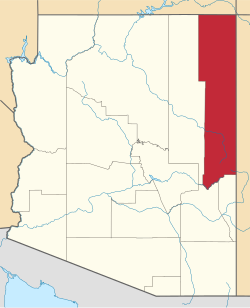History
Adamana was founded in 1896 when the railroad was extended to that point. [2]
The town was named for Adam Hanna, [3] a local rancher who was a distant relative of the late Mark Hanna, the original settler of the region. Originally the place was known as Adam Hanna's, as time passed and more people came to visit, the elision of a few letters gave us the name Adamana. [4]
A post office was established at Adamana in 1896, and remained in operation until 1969. [5]
In 1904 John Muir and his daughters, Helen and Wanda, were living at Adamana, Arizona at the Forest Hotel, a large rambling place by the railroad tracks run by a couple who gave guided tours of the Petrified Forest six miles south. From the hotel Muir would make regular trips to the Blue Forest (now Blue Mesa) making regular trips there alone or accompanied by the girls. [6]
Adamana's population was 25 in 1920, [7] 68 in 1940, [8] and 30 in the 1960 census. [9]
This page is based on this
Wikipedia article Text is available under the
CC BY-SA 4.0 license; additional terms may apply.
Images, videos and audio are available under their respective licenses.

